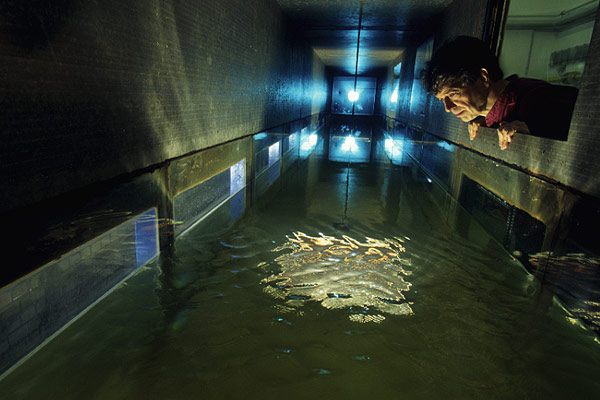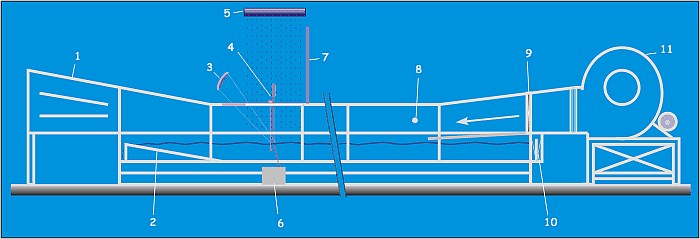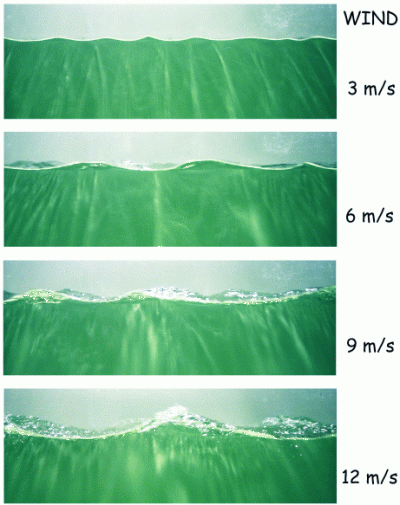WWK-Wiki am IfM
Am Windwellenkanal der Uni Hamburg werden grundlegende Untersuchungen durchgeführt zu Wechselwirkungen an der Wasseroberfläche und zu ihrer Fernerkundung. Flüsse von Energie, Impuls, Gas und Wärme, sowie die verantwortlichen kleinskaligen Prozesse, können gezielt variiert und untersucht werden. Hierzu finden regelmäßig Messkampagnen am Windwellenkanal statt, deren Ergebnisse wertvolle Beiträge zur Entwicklung von Theorien zu Wechselwirkungen zwischen Ozean und Atmosphäre sowie zur (Radar-) Fernerkundung der Meeresoberfläche liefern.

The interior of U Hamburg' wind-wave tank, seen from its leeward end. Foto (c) M. Steinmetz 2002.
The wind_wave tank was built in the early 1970s and is located in a hall at the Federal Institute of Waterways Engineering in Hamburg-Rissen. The water-filled part of the large facility is 24 m long and 1 m wide, and the air volume is 1 m high. The tank is filled with fresh water, a radial blower is used to generate wind speeds up to 25 m/s and a wave flap to generate long waves of frequencies between 0.7 Hz and 2.5 Hz.m/s erzeugt werden und mit einer Wellenklappe lange Wellen mit Frequenzen zwischen 0.7 Hz und 2.5 Hz.

Schematic side view of the wind-wave tank; 1: diffusor; 2: beach; 3: radar antennas; 4: wave height and slope sensors; 5: rain generator; 6: laser optics; 7: microwave absorber; 8: propeller anemometer; 9: honeycomb; 10: wave flap; 11: radial blower.
In the late 1990s, a rain generator was developed and installed to generate heavy rain of up to 300 mm/h on an area of 2.3 m². In the mid 2000s an air re-circulation was added and the tank was made air-tight, thereby allowing comprehensive gas exchange measurements.

Seitenansicht winderzeugter Wellen bei unterschiedlichen WIndgeschwindigkeiten.
The wind-wave tank is very well suited for experiments under controlled environmental conditions. E.g., in order to simulate biogenic films on the sea surface chemical model substances can be deployed, which form surface films of only one molecule thickness. The impact of those films on the small-scale wave and current field, and on the backscattered radar power, can be studied in great detail. Taking advantage of its flexible usage, the wind-wave tank can be well used to study a wealth of scientific aspects and to help in interpreting remotely sensed data.
Synthetik-Apertur-Radar (SAR) Aufnahme des Südchinesischen Meers, die von Bord des Europäischen UMweltsatelliten ERS-1 aus am 14. Mai 1998 um 0252 UTC gemacht wurde ((c) ESA). DIe hellen Flecken im unteren linken Bereich werden durch Starkregen verursacht, die länglichen dunklen Bereiche im oberen Bereich durch marine Oberflächenfilme. Bildgröße 100 km x 105 km.
Description
Description of UHH's wind-wave tank (M. Gade, 2003)
Previous Research
Practicals: Ozeanische Messübungen am WWK
 Interne Seiten für die Teilnehmer an den Messübungen.
Interne Seiten für die Teilnehmer an den Messübungen.

 ...zu den internen WWK-Seiten geht's hier.
...zu den internen WWK-Seiten geht's hier.  ... zurück zur KFEW3O-Seite...
... zurück zur KFEW3O-Seite...






